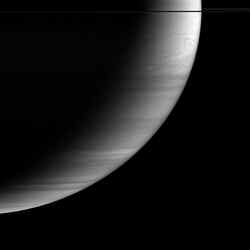
Saturn’s crescent. Image credit: NASA/JPL/SSI Click to enlarge
Feathery cloud bands fill Saturn’s graceful crescent. Features in the atmosphere are visible all the way to the terminator, the boundary between night and day, where the Sun’s rays are coming in almost horizontally.
Because it is possible to see down to the same level, regardless of how high the Sun is above the horizon, this indicates that the atmosphere above the clouds is relatively clear.
The dark line across the top of the image is the nearly edge-on ringplane.
The image was taken in infrared light (centered at 728 nanometers) with the Cassini spacecraft wide-angle camera on Oct. 31, 2005, at a distance of approximately 1.2 million kilometers (800,000 miles) from Saturn and at a Sun-Saturn-spacecraft, or phase, angle of 131 degrees. Image scale is 69 kilometers (43 miles) per pixel. The image was contrast enhanced to improve visibility of features in the atmosphere.
The Cassini-Huygens mission is a cooperative project of NASA, the European Space Agency and the Italian Space Agency. The Jet Propulsion Laboratory, a division of the California Institute of Technology in Pasadena, manages the mission for NASA’s Science Mission Directorate, Washington, D.C. The Cassini orbiter and its two onboard cameras were designed, developed and assembled at JPL. The imaging operations center is based at the Space Science Institute in Boulder, Colo.
For more information about the Cassini-Huygens mission visit http://saturn.jpl.nasa.gov . The Cassini imaging team homepage is at http://ciclops.org .
Original Source: NASA/JPL/SSI News Release
